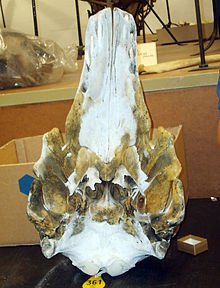Narluga
It has been suggested that this article be merged into Monodontidae. (Discuss) Proposed since January 2024. |
| Narluga | |
|---|---|

| |
| Specimen at Zoological Museum, Copenhagen
| |
| Scientific classification | |
| Domain: | Eukaryota |
| Kingdom: | Animalia |
| Phylum: | Chordata |
| Class: | Mammalia |
| Order: | Artiodactyla |
| Infraorder: | Cetacea |
| Superfamily: | Delphinoidea |
| Family: | Monodontidae |
| Hybrid: | Delphinapterus D. leucas × Monodon M. monoceros |
A narluga (
Discovery

The existence of narlugas had been hypothesized for decades before its discovery. There are 20 known cetacean hybrids in existence, with 7 of those occurring only in captivity.[3] In 1990, the researcher Mads Peter Heide-Jørgensen spoke to an
The hybrid genetics of the narluga was confirmed in 2019 when the genome of the specimen was sequenced. Carbon/nitrogen isotopic analysis also found that narlugas have a greater C/N concentration than both parent species.[1]
Feeding
Narwhals and beluga whales are both pelagic feeders, with the largest portion of their diet consisting of Arctic cod.[6] Through analysis of stable isotopes, Skovrind et al. determined that the hybrid had isotopic carbon readings consistent with that of a benthic foraging strategy.[1] The hybrid had outward-facing teeth in its bottom jaw which may have aided in this benthic foraging strategy, allowing it to capture prey more effectively, scooping it off the ocean floor. This proposed foraging strategy differs from that of the gray whale, which rolls on its side on the ocean floor to consume benthic prey.[7] This may fill the niche left open by the anthropogenically extinct Atlantic gray whale, a relative of the benthically feeding Pacific gray whale.
Species compatibility
Despite being each other's closest living relative phylogenetically, narwhals and beluga whales diverged an estimated four million years ago; however, it is predicted that gene flow continued until 1.25-1.65 million years ago.[8] Narwhals and beluga whales have overlapping ranges in the northern Atlantic and Pacific Oceans. As a result of climate change, Arctic cetaceans are at high risk for range contraction, which is likely to increase interspecific interaction between narwhals and belugas whales.[9] Both species exhibit seasonal migrations, and they are most likely to overlap with one another in their summering grounds.[1]
Beluga whales and narwhals use high frequency vocalizations for echolocation; while beluga whales typically utilize higher frequency vocalizations than do narwhals, their vocalization ranges are overlapping.[10] Both species show evidence of context-dependent vocalizations.[11][12] This indicates possible social compatibility between the two species. However, narwhals also show evidence of pod-specific vocalizations,[12] potentially serving as a barrier to hybridization with beluga whales. The two parental species share a spring mating season,[1] but their mating systems differ. Beluga whales are thought to be more monogamous, whereas narwhals operate under a more polygamous mating system,[13] further differentiating the two socially. Current data on narwhals, beluga whales, and their hybrids is not sufficient to state definitively, but the prevailing thought is that the hybrid would likely not be reproductively viable.[8] In spite of their potential for social incompatibility, the last recorded sighting of the two species comingling was in 2018, when a narwhal was captured via drone footage schooling with a pod of beluga whales.[14]
References
- ^ PMID 31221994.
- ISBN 978-0-87196-871-5.
- ^ ]
- ^ ISSN 0824-0469.
- ^ Klein, Joanna (20 June 2019). "Meet the Narluga, Hybrid Son of a Narwhal Mom and a Beluga Whale Dad". The New York Times.
- ISSN 1751-8369.
- ISSN 0824-0469.
- ^ PMID 31054839.
- ISSN 2666-9005.
- ISSN 0001-4966.
- S2CID 128544174.
- ^ ISSN 0824-0469.
- ISSN 0824-0469.
- ^ Katz, Brigit. "Group of Belugas May Have Adopted Young Narwhal". Smithsonian Magazine. Retrieved 2023-11-01.
